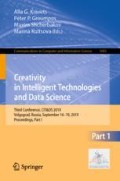Abstract
The paradigm of using artificial neural networks (ANN) for solving intellectual problems of chemistry and chemical technology is considered: classification, identification, design, modeling, optimization, and others. Using the example of studying the applicability of colored graphs in the neural network analysis of chemical structures at the site «structure-property-application» relationship, the possibility of identifying chemical structures when creating actual substances is shown. Artificial neural network learning to identify graphs is shown. The results obtained are mathematical software that allows solving creative problems and creating decision rules when choosing chemical-technological systems formalized in terms of graph theory and intended to support decision-making.
Access this chapter
Tax calculation will be finalised at checkout
Purchases are for personal use only
References
Glebov, M.B., Galushkin, A.I.: The use of neural networks in chemistry and chemical technology. Neurocomput. Dev. Appl. (3–4), 66–107 (2003)
Smith, K.A.: Neural networks for combinatorial optimization: a review of more than a decade of research. Inf. J. Comput. 11(1), 15–34 (1999)
Hung, D.L., Wang, J.: Neurocomputing 51, 447–461 (2003)
Devillers, J. (ed.): Neural Networks in QSAR and Drug Design. Academic Press, London (1996)
Halbershtam, N.M., Baskin, I.I., Palyulin, V.A., Zefirov, N.S.: Neural networks as a method of finding dependencies structure - a property of organic compounds. Successes Chem. 72(7), 706–727 (2003)
Tumanov, V.E.: The use of an artificial neural network to predict the reactivity of molecules in radical reactions. Inf. Technol. 5, 11–15 (2010)
Stasyuk, V.V.: Prediction of sensitivity to impact of explosives by neural networks with preliminary grouping of data. Fundam. Res. 12–6, 1139–1143 (2015)
Baskin, I.I., Madzhidov, T.I., Antipin, I.S., Varnek, A.A.: Artificial intelligence in synthetic chemistry: achievements and prospects. Chem. Adv. 86(11), 1127–1156 (2017)
Heung, B.K., Sung, H.J., Tag, G.K., Kyu, H.P.: Fast learning method for learning. Neurocomputing 11, 101–106 (1996)
Qian, N.: On the dynamic algorithms. Neural Netw. 12, 145–151 (1999)
Skorobogatchenko, D.A.: Methods of predicting the operational condition of roads based on the representation of fuzzy sets by neural networks. Proc. High. Educ. Inst. Build. 2(626), 72–77 (2011)
Germashev, I.V., Derbisher, E.V., Alexandrina, A.Y., Derbisher, V.E.: Hazard evaluation of organic substances using artificial neural networks. Theor. Found. Chem. Technol. 43(2), 225–231 (2009)
Germashev, I.V., Derbisher, V.E.: Use of fuzzy sets for computer processing of information on chemical structures and substances. Control Syst. Inf. Technol. 2, 76–80 (2008)
Germashev, I.V., Derbisher, V.Ye.: Solving problems in chemical technology using fuzzy sets: monograph, p. 142. GOU VPO Volgograd State Pedagogical University, Peremena, Volgograd (2008)
Germashev, I.V., Derbisher, V.E., Losev, A.G.: Analysis and identification of the properties of complex systems in the natural sciences: monograph. FSAEI of HE, 271 p. Volgograd State University Publishing House, Volgograd (2018)
Derbisher, V.E., Germashev, I.V., Derbisher, E.V.: Fuzzy sets in chemical technology. Proc. High. Educ. Inst. Chem. Chem. Technol. 1, 104–110 (2008)
Germashev, I.V., Derbisher, V.Ye., Derbisher, E.V.: Making decisions on the choice of ingredients of polymeric compositions in conditions of fuzzy information. Plastics 7, 24–27 (2007)
Germashev, I.V., Derbisher, V.E., Tsapleva, M.N., Derbisher, E.V.: Sorting of additives to polyethylene based on the non-distinct multitudes. Russ. Polym. News 6(2), 53–57 (2001)
Emelichev, V.A., Melnikov, O.I., Sarvanov, V.I., Tyshkevich, R.I.: Lectures on graph theory. Science, 384 p. (1990)
Author information
Authors and Affiliations
Corresponding author
Editor information
Editors and Affiliations
Rights and permissions
Copyright information
© 2019 Springer Nature Switzerland AG
About this paper
Cite this paper
Germashev, I.V., Derbisher, E.V., Derbisher, V.E. (2019). Theoretical Bases of the Application of Various-Color Graphs in the Solution of Intellectual Chemical Tasks. In: Kravets, A., Groumpos, P., Shcherbakov, M., Kultsova, M. (eds) Creativity in Intelligent Technologies and Data Science. CIT&DS 2019. Communications in Computer and Information Science, vol 1083. Springer, Cham. https://doi.org/10.1007/978-3-030-29743-5_25
Download citation
DOI: https://doi.org/10.1007/978-3-030-29743-5_25
Published:
Publisher Name: Springer, Cham
Print ISBN: 978-3-030-29742-8
Online ISBN: 978-3-030-29743-5
eBook Packages: Computer ScienceComputer Science (R0)

